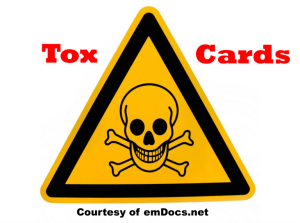Author: Joshua Bucher, MD (Assistant Professor, Department of EM, Rutgers – RWJMS; Assistant EMS Medical Director, RWJ-MHS) // Edited by: Alex Koyfman, MD (@EMHighAK, EM Attending Physician, UTSW / Parkland Memorial Hospital) and Brit Long, MD (@long_brit, EM Attending Physician at SAUSHEC)
Case
A 27-year-old male is brought in by EMS after sustaining several gunshot wounds. On arrival, the patient withdraws from painful stimuli, does not open his eyes and makes incomprehensible noises. His heart rate is 130 bpm, blood pressure 84/42, RR 26, and Sp02 88%. While preparing to begin resuscitation, what are the first and most important steps?
Airway
As with all critical patients, the first step is airway management. Care should be taken and best practices should be followed to allow for first pass success including preoxygenation if possible to avoid desaturation. Resuscitation before intubation if possible is important. The appropriate induction agent is of vital importance. Ketamine is associated with the most neutral hemodynamic properties, and it is also the ideal agent for head injured patients.1,2 By maintaining hemodynamic stability and its dissociative properties, it is useful to blunt the response to laryngoscopy. Fentanyl is another option as well at doses 3-5 mcg/kg IV.3
Gunshot wounds may directly involve airway structures. In that case, surgical airway may be preferred, compared to endotracheal intubation. Team preparation is key for this step, and verbalizing the need for potential surgical airway is essential.
C-Spine
Along with airway management, unless there is a focal neurologic injury, it is not necessary to perform cervical spine immobilization of patients suffering from gunshot wounds. This is based on a strong retrospective study as well as supported by the NAEMSP/ACS-COT position paper on spinal immobilization.4 Cervical spine immobilization can directly interfere with airway management, obscure the mouth opening, require increased laryngoscopic force and can lead to worse patient outcomes in the setting of a failed airway.5-7
Breathing
Breathing can be significantly affected depending on where your patient has been shot. Any sign of a tension pneumothorax (decreased breath sounds on one side, tracheal deviation, or hemodynamic instability) needs to be immediately treated with needle decompression or finger thoracostomy followed by tube thoracostomy. A standard pneumothorax can be treated with tube thoracostomy, either during the primary survey or after. High flow NRB oxygen is indicated as well. A GSW to the abdomen may cause difficulty with ventilation due to pain or abdominal distention, and this needs to be monitored.
There have been some newer developments in the management of pneumo/hemothoraces. Inaba et al. described their experience using a smaller chest tube catheter for traumatic pneumo- or hemothoraces and found no difference in patient outcomes with 28-32 vs traditional 36-40 French chest tubes.8 Furthermore, Russo et al. studied a new method of using a pigtail catheter in a swine model vs traditional chest tube and found that both were able to drain the same amount of blood from a hemothorax.9 Although pigtail catheters have been used for pneumothoraces, this is a good step forward towards utilization of more patient oriented resources in the management of a hemothorax. The EAST guidelines currently recommend tube thoracostomy for all hemothoraces. They also suggest that occult pneumothoraces be treated with observation in a stable patient, even with positive pressure ventilation.10
Circulation
The next step of the primary survey is circulation. At this point, fluid resuscitation should begin with blood products in the critically injured patient. Permissive hypotension should be considered to target a systolic of 90 mm Hg or a MAP or 45 – 50 mm Hg, although further prospective studies are required.11 In addition, blood products should be transfused in a 1:1:1 ratio of 6 units of PRBCs:6 units FFP:1 pack of platelets, based on the results of the PROPPR trial.12 Furthermore, crystalloid fluids should be limited unless absolutely necessary to maintain perfusion.13 Fluids can theoretically prohibit clotting and dilute hemoglobin carrying capacity, and this recommendation is supported by the EAST guidelines.14
Thoracotomy
Emergency department thoracotomy is a life-saving procedure for patients with a very low survival. The EAST guidelines define signs of life as pupillary response, ventilation, vital signs, cardiac electrical activity, or extremity movement. They released the following evidence-based recommendations.
Recently, there has been research looking at this issue. Inaba et al prospectively studied patients undergoing resuscitative thoracotomy in the ER and related it to the FAST exam. They found that if the FAST exam was negative for pericardial fluid or any cardiac activity, the sensitivity was 100% for predicting the patient would not survive.15 This can be added to the EAST guidelines to determine the efficacy and necessity of thoracotomy.
REBOA
Resuscitative endovascular balloon occlusion of the aorta (REBOA) is a last-ditch procedure that can stop hemorrhagic shock in patients with bleeding below the diaphragm. The instrument is comprised of a sheath and balloon, which is inserted into the femoral artery and inflated at one of three areas in order to stop blood flow. This can be especially useful for pelvic fractures with hemorrhage or other intra-abdominal hemorrhagic processes. There currently is limited data since it is a novel device, but it appears to be promising for specific situations. You can read more about REBOA at http://lifeinthefastlane.com/ccc/resuscitative-endovascular-balloon-occlusion-aorta-reboa/.
Extremity Hemorrhage
I want to briefly mention two specific interventions that are geared towards pre-hospital providers. The first intervention is the use of tourniquets for extremity trauma. We now have a large body of literature that supports the use of tourniquets as a life-saving device for extremity trauma with minimal risk of side effects.16 Likewise, the use of clotting agents, such as the commercially named QuickClot agent, are safe and effective to stop bleeding and are recommended by the Tactical Combat Casualty Care guidelines for hemorrhage not amenable to tourniquet placement.16 These two options are highly efficacious and warrant our attention.
Case resolution:
The patient is intubated appropriately. Bilateral chest tubes are placed, with immediate return of 2L from the left chest and a large rush of air from the right. Massive transfusion protocol is activated, and the patient is immediately transfused blood and plasma products. An E-FAST is performed, showing no pericardial fluid but large intraabdominal fluid. The patient is taken to the operating room by the trauma team with successful repair of his thoracic and abdominal injuries and makes a full recovery.
Take Home Points
- Utilize ketamine for airway management as it is the most hemodynamically neutral agent.
- Use traditional large chest tubes for hemothoraces and large pneumothoraces.
- Aggressively resuscitate with blood products for the exsanguinating trauma patient.
References / Further Reading
- Bucher J, Koyfman A. Intubation of the Neurologically Injured Patient. The Journal of emergency medicine. 2015;49(6):920-927.
- Cohen L, Athaide V, Wickham ME, Doyle-Waters MM, Rose NG, Hohl CM. The Effect of Ketamine on Intracranial and Cerebral Perfusion Pressure and Health Outcomes: A Systematic Review. Annals of emergency medicine. 2014.
- Pouraghaei M, Moharamzadeh P, Soleimanpour H, et al. Comparison between the effects of alfentanil, fentanyl and sufentanil on hemodynamic indices during rapid sequence intubation in the emergency department. Anesthesiology and pain medicine. 2014;4(1):e14618.
- White Iv CC, Domeier RM, Millin MG, Standards, Clinical Practice Committee NAoEMSP. EMS Spinal Precautions and the Use of the Long Backboard -Resource Document to the Position Statement of the National Association of EMS Physicians and the American College of Surgeons Committee on Trauma. Prehospital emergency care : official journal of the National Association of EMS Physicians and the National Association of State EMS Directors. 2014;18(2):306-314.
- Gruen RL, Jurkovich GJ, McIntyre LK, Foy HM, Maier RV. Patterns of errors contributing to trauma mortality: lessons learned from 2,594 deaths. Annals of surgery. 2006;244(3):371-380.
- Santoni BG, Hindman BJ, Puttlitz CM, et al. Manual in-line stabilization increases pressures applied by the laryngoscope blade during direct laryngoscopy and orotracheal intubation. Anesthesiology. 2009;110(1):24-31.
- Goutcher CM, Lochhead V. Reduction in mouth opening with semi-rigid cervical collars. British journal of anaesthesia. 2005;95(3):344-348.
- Inaba K, Lustenberger T, Recinos G, et al. Does size matter? A prospective analysis of 28-32 versus 36-40 French chest tube size in trauma. The journal of trauma and acute care surgery. 2012;72(2):422-427.
- Russo RM, Zakaluzny SA, Neff LP, et al. A pilot study of chest tube versus pigtail catheter drainage of acute hemothorax in swine. The journal of trauma and acute care surgery. 2015;79(6):1038-1043; discussion 1043.
- Mowery NT, Gunter OL, Collier BR, et al. Practice management guidelines for management of hemothorax and occult pneumothorax. The Journal of trauma. 2011;70(2):510-518.
- Dunser MW, Takala J, Brunauer A, Bakker J. Re-thinking resuscitation: leaving blood pressure cosmetics behind and moving forward to permissive hypotension and a tissue perfusion-based approach. Critical care. 2013;17(5):326.
- Holcomb JB, Tilley BC, Baraniuk S, et al. Transfusion of plasma, platelets, and red blood cells in a 1:1:1 vs a 1:1:2 ratio and mortality in patients with severe trauma: the PROPPR randomized clinical trial. JAMA : the journal of the American Medical Association. 2015;313(5):471-482.
- Chatrath V, Khetarpal R, Ahuja J. Fluid management in patients with trauma: Restrictive versus liberal approach. Journal of anaesthesiology, clinical pharmacology. 2015;31(3):308-316.
- Cotton BA, Jerome R, Collier BR, et al. Guidelines for prehospital fluid resuscitation in the injured patient. The Journal of trauma. 2009;67(2):389-402.
- Inaba K, Chouliaras K, Zakaluzny S, et al. FAST ultrasound examination as a predictor of outcomes after resuscitative thoracotomy: a prospective evaluation. Annals of surgery. 2015;262(3):512-518; discussion 516-518.
- Defense Do. Tactical Combat Casualty Care Guidelines for Medical Personnel 2015.










2 thoughts on “Pearls for the management of GSW associated traumatic injury”
Great post. emdocs has been putting out some gold recently. Quick question re: Ketamine. The article mentions that it is the most hemodynamically neutral agent for intubation. I’m EM trained and have been taught (and experienced in multiple cases) that Ketamine increases sympathetic tone and causes increase in HR and BP. Caveat being the patient who is in shock, in which there can be a paradoxical decrease in BP. Etomidate has always been my go-to for a hemodynamically neutral sedation agent. Thoughts?